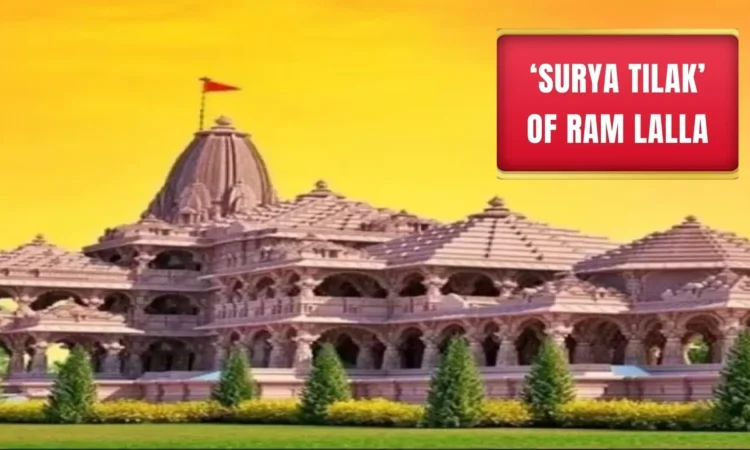Table of Contents
Description:
Many scientific discoveries have been made from religious quests in India since ancient times. That tradition continues even in the 21st century. Using science, Indian scientists gifted ‘Surya Tilak’ to the statue of Ramlala sitting in the sanctum sanctorum of Ram temple in Ayodhya. What is this sun tilak?
Thank you for reading this post, don't forget to subscribe!Harmony of Faith and Science: Modern Scientific Traditions Rooted in Ancient Indian Wisdom
In the Western world, there has always been a conflict between religion and giraffe, that is, science. It is argued that man was born by God, not by evolution. In India, however, religion and science have been holding hands since the very beginning of creation. Many scientific discoveries have been made from religious quests in India since ancient times. That tradition continues even in the 21st century. Before the spacecraft’s launch, ISRO scientists performed puja at the Balaji temple.
Image credit: Republic World.
Future Illumination: The Anticipated Surya Tilak at Ram Temple and the Artistry of Light in Worship
However, this Surya Tilak will not appear now. Because only the sanctum sanctorum of the temple has been completed. Director of Roorkee Central Building Research Institute. Pradeep Kumar Ramancharla said, ‘When the full temple is built, the Surya Tilak process will be fully functional. At present, only the structure is built up to the first floor. All the equipment that was supposed to be installed in the sanctum and ground floor for Surya Tilak, has been completed.
Once the entire temple is built, a ray of sun will fall on the forehead of the Ram idol for 6 minutes at noon every Ram Navami day. Indeed, the rays of the sun from the third floor of the temple will reach the sanctum sanctorum through various mirrors and lenses. And in this way, the sunlight will come to the sanctum sanctorum.
Harmonizing the Cosmic Dance: 19-Year Gearing for Precision in Surya Tilak at Ram Temple
However, it was a big challenge for scientists and engineers to ensure that the Surya Tilak process was done properly. Because, in Hinduism, Tithi is determined according to the lunar calendar. The day of Ram Navami is also fixed according to the lunar calendar. But, the Sun does not stay in the same position every year on that day. After 19 years, the sun returns to its previous position on a lunar day.
The middle years are in other positions. So the main problem for the scientists was to bring harmony between the lunar and solar calendars. For this, 19 special gears are being installed. With these gears, every year on Ram Navami, the position of the lenses and mirrors will change with the position of the sun.
Video Credit: NDTV
Innovations in Worship: Solar-Powered Precision and Unique Challenges in Ram Temple’s Surya Tilak Mechanism
However, no electricity or batteries are used to operate these gears automatically. Instead, solar energy is being used. However, initially, there was a plan to meet all the electricity needs of the Ram temple with solar energy, but the plan had to be scrapped in the end. Nripendra Mishra, chairperson of the temple construction committee, said the solar power project had to be scrapped due to the presence of the ‘monkey army’.Brass is used instead of iron in making the gears.
The periscope-like device has been designed by the Indian Institute of Astrophysics, Bangalore. And, technical support was provided by a Bengaluru-based company named Optika. This company manufactures lenses and brass tubes. They, in turn, developed lenses, mirrors and gears. The whole process was supervised by CBRI. This central organization also helped in the design of the Ram temple.
Conclusion:
In the heart of the Ram temple project, the ingenious creation of ‘Surya Tilak’ stands as a testament to the seamless integration of religious tradition and scientific innovation. As India embraces the 21st century, this symbolic gift to the idol of Ramlala reflects the continuation of a historical journey where science and spirituality have walked hand in hand. Despite the current pause in the appearance of Surya Tilak, the meticulous planning and solar-powered precision signal a future where the sanctum will come alive with sunlight, marking a harmonious union of ancient rituals and modern technology.
The challenges faced by scientists, from lunar-solar calendar alignment to the intricate workings of gears powered by solar energy, showcase the dedication to bringing this unique tradition to life. As the full temple unfolds, the promise of Surya Tilak becoming fully functional brings anticipation for a celestial spectacle during every Ram Navami, bridging the celestial and the terrestrial in the sacred space of the Ram temple.
Thumbnail credit: Republic World.
- FASTag KYC update: Updation of KYC for FASTag before 31st January; Step-by-step Process:
- Tejas vs. Thunder: China’s “Wrestles,” JF-17 With a fighter deal with Nigeria, India’s LCA Tejas is fully engaged in backchannel diplomacy.
- Real Madrid Victory: At Las Palmas, Aurelian Tchouameni gives Real Madrid a late victory.
- Bharat Ratna: Must-know Facts and Important FAQs on the Bharat Ratna Award
- Klopp is leaving Liverpool at the end of the season
